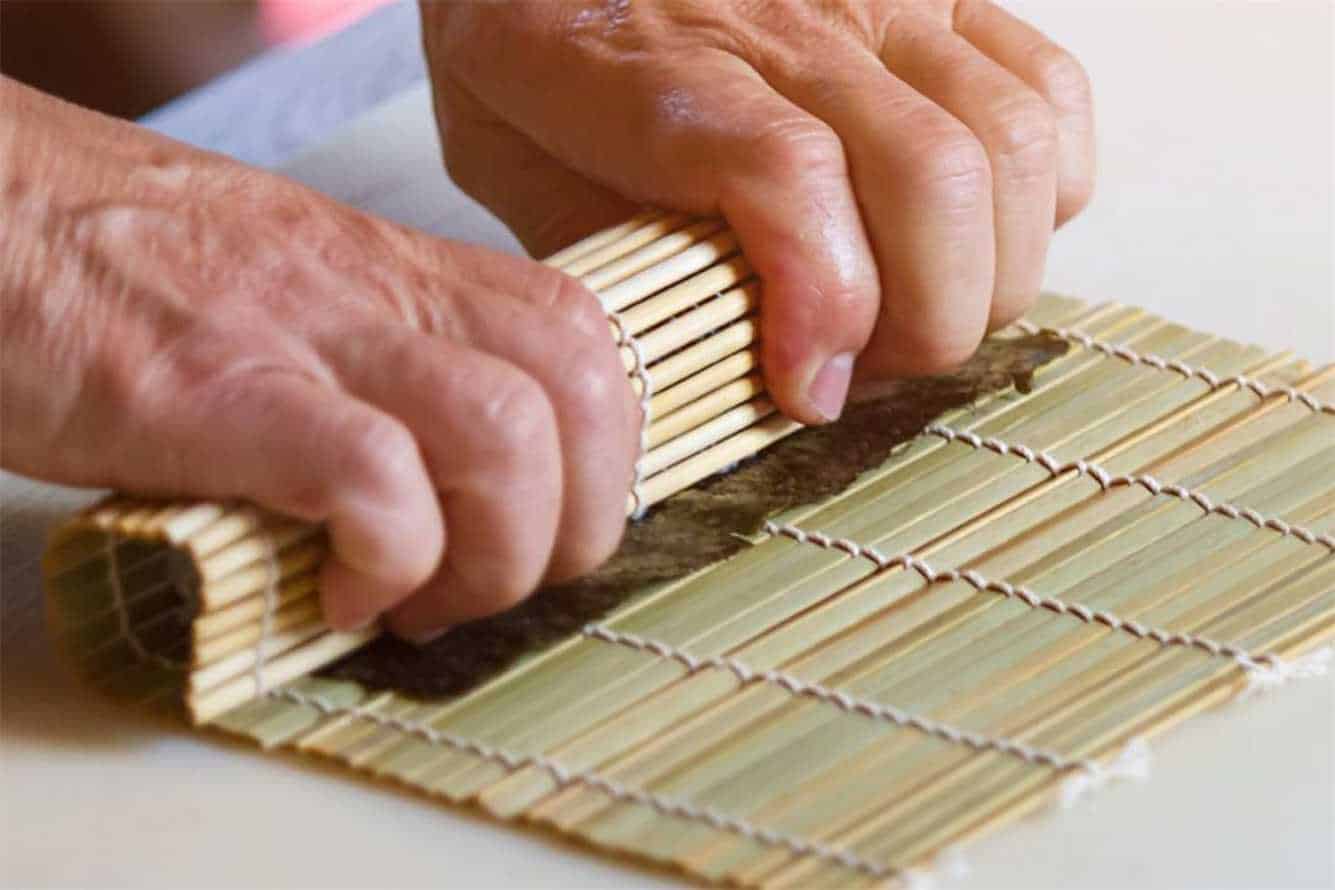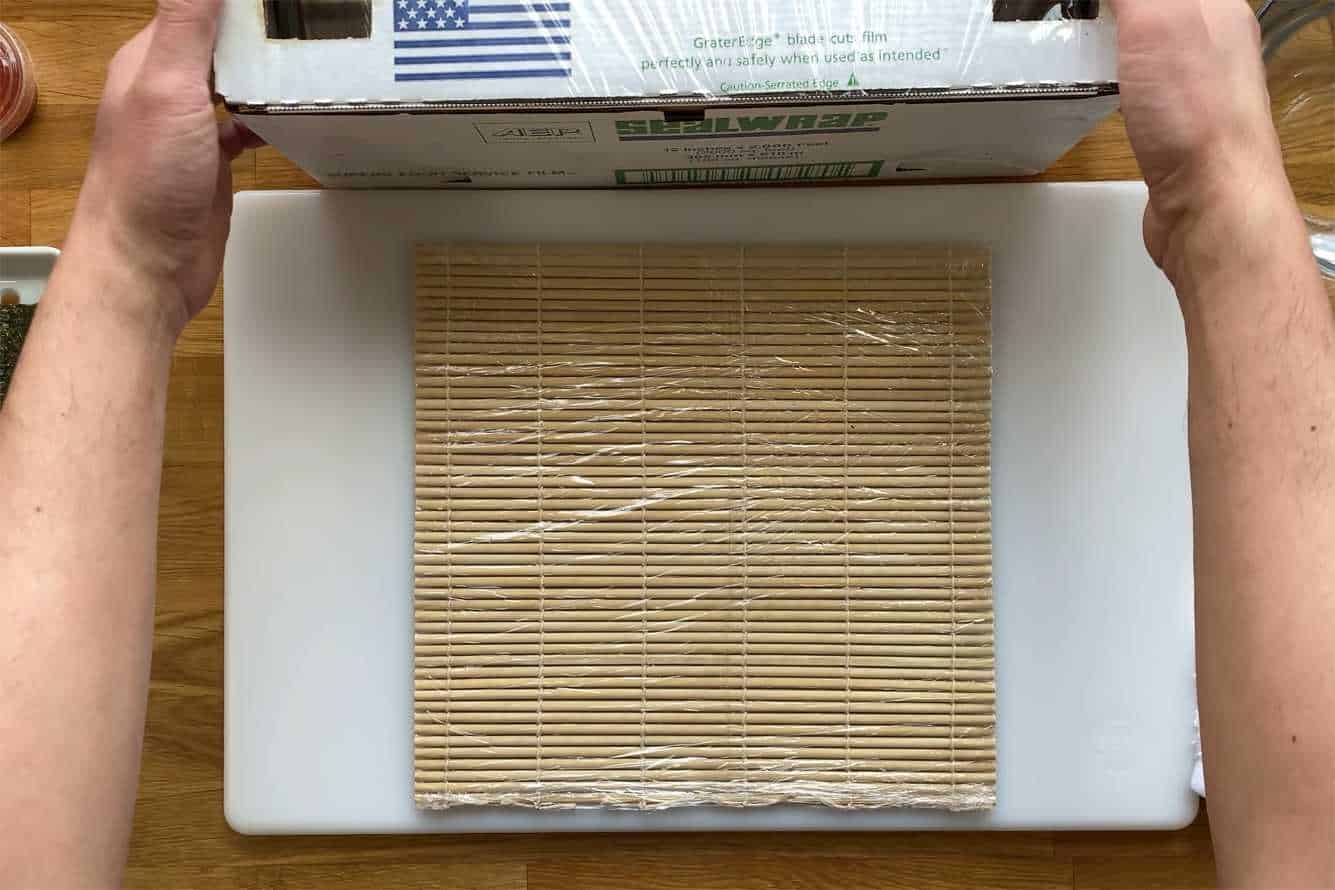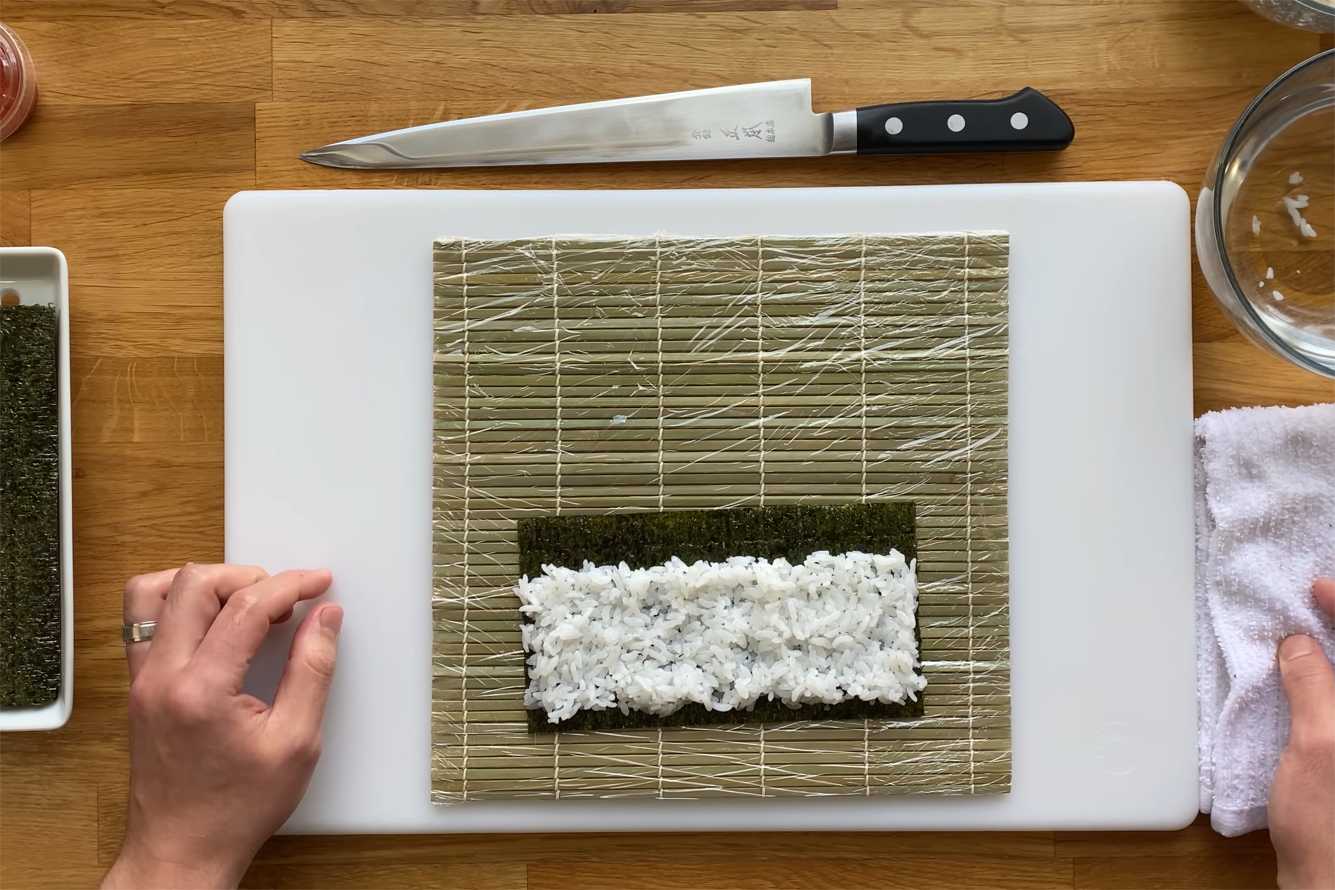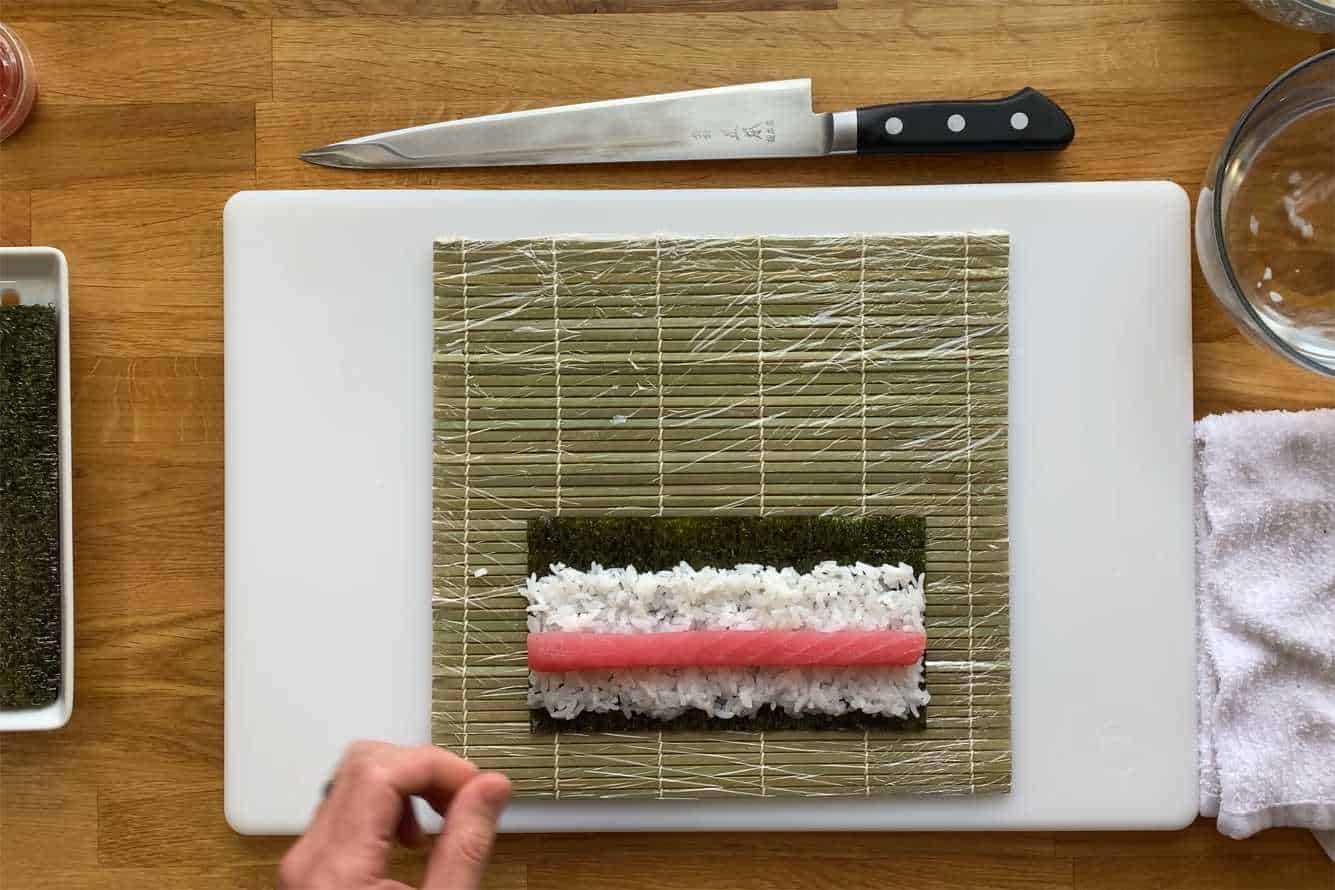Sushi rolling may appear complicated, but it is simple if you have the appropriate tools. Sushi rolls require some practice. Your first few attempts may be far from perfect.
However, the return is well worth the work you put in. Continue reading and learn how to roll sushi by following the step-by-step guide below.
Using a Traditional Bamboo Mat
Bamboo mats are relatively inexpensive and easy to come by. Most Asian stores have them. If you don’t have access to an Asian shop, you can buy online. Amazon sells a bamboo mat for $4.00. Here are the steps you should follow:
Step 1: Prepare the bamboo mat
Place the mat in a plastic zip-lock bag before using it. Rice will not stick to the bamboo because of the plastic. It’s not necessary to vacuum seal the bamboo mat; just ensure it’s securely wrapped in the plastic.
Allow some air to escape by leaving a gap on the side. This step prevents bubbles from forming, making rolling an even roll straightforward.
Before rolling the rice, run the zip-lock bag under cold water to keep the rice from sticking. The moisture will prevent the rice from sticking to the plastic.
Step 2: Place a seaweed sheet on the bamboo mat
Nori sheets have two sides, one rough and one smooth. Lay the sheet with the rough side facing up.
Some folks don’t use nori sheets and instead use a plastic sheet to dab their favorite sauce into. However, rolling sushi without a nori sheet can be difficult. Just ensure that you’re using sticky rice so your sushi won’t fall apart.
Step 3: Spread the sushi rice
Spread the rice evenly after the nori and mat are in place. Don’t make a thick layer to accommodate other ingredients.
Ensure that the seaweed sheet has enough room at the bottom and top. When you start rolling and squeezing the rice, about one inch is good to keep it from overflowing.
Step 4: Add your pick of ingredients
Once the rice is set, add the rest of the ingredients. Always keep it vertically aligned. It’s not necessary to spread it out like rice. Your sushi will not look decent if you do so.
Step 5: Keep the mat in place
Position your thumbs under the mat and gently raise the edges. Ensure that you’re gripping the plastic liner as well.
Step 6: Pull the mat from the bottom
Roll the bamboo mat with the rest of your fingers in a rolling manner. Ensure you’re gripping the mat tight to keep the ingredients from leaking.
Step 7: Roll firmly
Roll the sushi until it resembles a log. Apply pressure on the roll using your hands to make it circular.
Lift the mat’s side a little, roll it again, and apply pressure to accentuate the circular shape. Keep rolling until you approach the sheet’s other edge.
Step 8: Cut the sushi into slices
Without removing the plastic liner, unroll the mat. You now have freshly rolled sushi in your hands. You may now slice your sushi roll to a thickness of roughly 3/4 inches.
For home eating, some people would like thicker slices. Slice carefully to avoid unraveling the roll.
Using a Dish Towel
A bamboo mat isn’t required for a beautiful sushi roll, so don’t worry if you don’t get one. You can use a dish towel, also called a tea towel, and it works well.
- Prepare the dish towel: Begin your roll with the same setup as a bamboo mat when using a dish towel. This time, use plastic wrap because a rough dish towel can grab and rub against the nori sheet.
- Spread sushi rice: Place and spread the sushi rice on the nori sheet with your fingers. It should cover the sheet equally from the closest edge to approximately one inch from the other edge. Keep your hands moist using a mixture of rice vinegar and water. Don’t mash or squeeze the rice; it won’t stick together correctly when you roll it.
- Place the filling ingredients: Begin spreading the filling ingredients. Starting at the near side of the rice layer, arrange your items. Each element should be in its place, with every row separated by a tiny gap. The following are some frequent component combinations: [Salmon or tuna only], [Cucumber, avocado, daikon, yellowfin], [Avocado, cucumber, shrimp tempura], [Tuna, salmon, crab sticks, tempura batter, avocado]
- Hold the mat’s edge using your thumbs: Begin from the edge where the first ingredient is located. Fold the nori over the first ingredient by lifting the dish towel’s edge. Ensure the elements stay in place, and the rice doesn’t fall apart.
- Keep rolling the sushi: Remove the towel as you roll the sushi and slip the nori’s front edge inside the roll. Roll slowly to ensure that the sushi is evenly distributed.
- Roll up tighter: To prevent the ingredients from spilling out when you cut the roll, tighten it. Use the dish towel to tighten, but not too firmly. Roll it back and forth on the dish towel to seal the sushi roll.
- Allow a minute for the roll to cool before slicing it: Let your sushi roll cool for about a minute. You may use this interval to prepare your next sushi roll. This waiting time allows the seaweed sheet to absorb some moisture from the rice, making it unlikely to shred.
- Slice the sushi roll: Slice the roll with a sharp, moist knife. The volume of ingredients determines the cuts’ thickness. If the roll contains additional components, make the slices thinner.
- Serve right away: Sushi tastes best when it’s freshly prepared. It’s best not to keep it in the fridge for a later date. Experiment with diverse combinations of ingredients until you discover your favorites.
Additional Sushi Rolling Tips and Tricks
Choose the proper tools
You can roll sushi with a dish towel, but a bamboo mat makes it easier. Always place a layer of plastic between the mat and the nori sheet to keep it clean.
Using plastic wrap between the seaweed and the rice holds moisture and makes the seaweed more malleable when rolling. It’s also a terrific way to avoid cleaning your bamboo mat or dish towel.
Wipe your knife using a moist dish towel between every cut
Before slicing, soak your knife in cold water. To prevent the rice from clumping and becoming messy, wipe the blade after each cut. Your cut will be cleaner if the knife is sharp.
The loosest portion of your sushi roll will always be the ends, so be extra careful, or your hard work may unravel.
Maintain wet hands while rolling
Sushi is best made with hands. The rice will not stick to the plastic gloves due to this. Keep your hands wet and clean while spreading the components.
So, have a tiny bowl of water close to you and dampen your hands frequently. Also, take care not to overwork the rice when working with it – it needs to breathe!
Also, massage a tiny bit of vinegar between your fingers to keep the ingredients from clumping together. Vinegar will also give the roll a slightly sour flavor.
Avoid overstuffing your sushi roll
Never overfill your sushi roll with everything that you want to eat. Because the nori can’t contain everything, you can’t close your roll. Hence, the roll will collapse.
Overfilling is the most prevalent cause of most rolls falling apart. Too much rice is sometimes to blame. What can you do? When making your rolls, use the right amount of rice.
Just use a ¼ inch thick layer of rice and a half-inch thick layer of filling. Prepare separate rolls instead if you wish to try different fillings.
Use quality fish
If you’re making sushi with tuna or other seafood, make sure it’s good quality. Sushi rolls must be free of dull-colored or brownish cuts.
It would be best if you could serve fresh fish. The fish is beginning to oxidize when its vibrant color fades. In other words, it’s starting to go bad.
Choose the proper cut in addition to the quality. Instead of steaks, choose fillets to give your sushi a more admirable form when sliced.
Don’t expose the seaweed sheet to the air
After removing a seaweed sheet from its box, use it right away. The sheet absorbs moisture after being exposed to the air for a long time. If this happens, it will not stick well, and your sushi roll will disintegrate.
Find your rolling style
Rolling sushi towards yourself may be more manageable if you’re a newbie. This style allows you to identify and remedy errors rapidly.
On the other hand, most sushi cooks like to roll away from themselves. Using your index fingers, you can control the contents more. It’s also easier to turn the rollover from behind while maintaining a solid grip with your other hand.
It makes no difference which direction you prefer to roll. Experiment with both ways to see which one you like. After all, preparing sushi should be enjoyable as well!
Summary
Sushi comes in different forms. The roll is undoubtedly trendy. You can prepare a roll with almost any combination of ingredients.
You may also choose to prepare it with or without a bamboo mat. Follow the step-by-step guide above on how to roll sushi and wow your guests at your next social gathering!

Hiroshi Nakamura, a Tokyo-born sushi chef turned US-based writer and critic, is the voice behind ichisushi.com, blending traditional sushi wisdom with modern insights.












